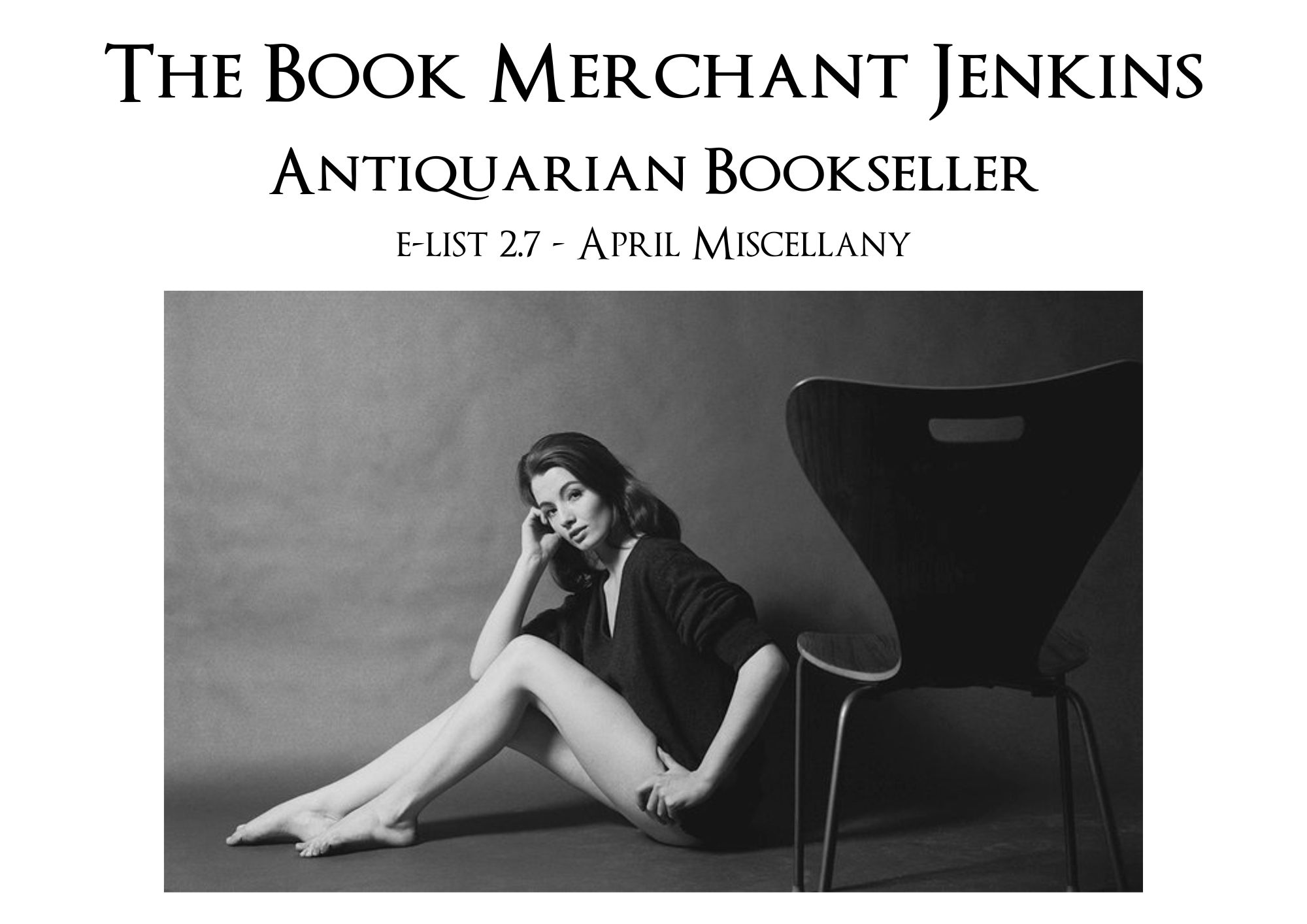Prices in AUD. Shipping worldwide. Flat rate $8 postage per order within Australia. International by weight calculated at checkout. Read full terms.
-
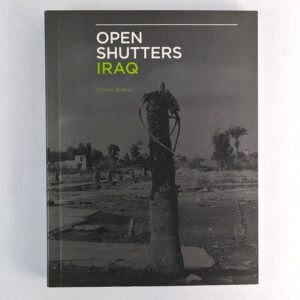
Open Shutters Iraq
AU$50.00 Read MoreAdd to cartEugenie Dolberg
London: Trolley, 2010.“This book is a collection of individual photographs and photographic essays made by women from Baghdad, Basra, Falluja, Kirkuk and Mosul in 2006/7. These women were not photographers or writers, but were brought together by their need to tell their stories.” (from preface)
-
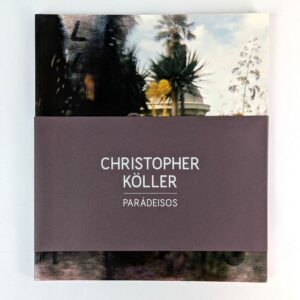
Paradeisos
AU$40.00 Read MoreAdd to cartChristopher Koller
Melbourne: M.33, 2011.“Produced over a period of 12 years, Christopher Koller’s plastic camera photographs of gardens and otherwise mediated greenery forge a very different atmosphere to what one would expect from such subject matter. Warped, stretched and almost affronting in their blurred optical qualities, the images that fill Paradeisos are vivid and almost visceral in their odd beauty.” (publisher’s blurb)
-
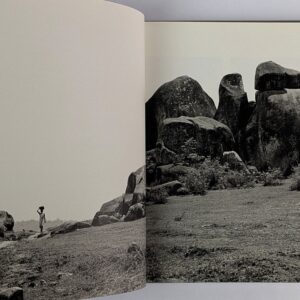
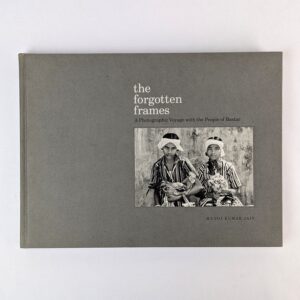
The Forgotten Frames: A Photographic Voyage with the People of Bastar
AU$40.00 Read MoreAdd to cartManoj Kumar Jain
[Uttar Pradesh]: Manoj Kumar Jain, 2014. -
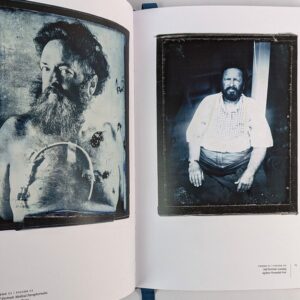
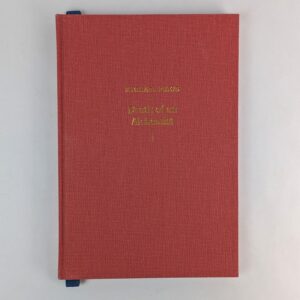
Death of an Alchemist
AU$800.00 Read MoreAdd to cartMichael Prior
Melbourne: Prior Art, 2019.A short compendium of photo-alchemical works chronicling the photographer’s passage toward the void. The final published work by experimental photographer Michael Prior documenting the effects of advanced myeloma on his body through alternative photographic processes. The works are arranged into three themes: Shades of the Alchemist; Garden Images. The Premonitory Return to Nature; The Hospital Room and its Uncanny Inhabitants. Each image has an accompanying commentary relating to the individual image as well as the broader themes, technical and philosophical, which underlie their creation. An accompanying exhibition was held at Fox Darkroom & Gallery, 16 February – 3 March 2019. Prior passed away in May of that year. Preface by Ellie Young. Editing by Dr Dianne Clifton and Richard Freadman. Elegantly bound by Nikola Doslov of Renaissance Bindery. Unrecorded in OCLC or Trove. This copy inscribed by Prior.
-
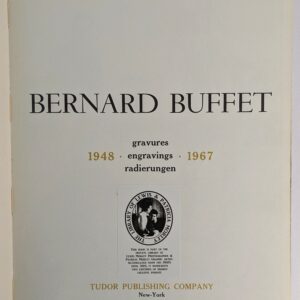
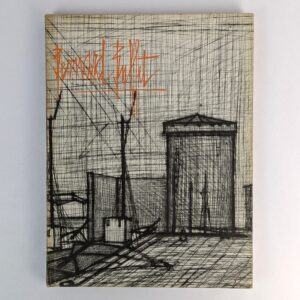
Bernard Buffet: Gravures, Engravings, Radierungen, 1948-1967
AU$50.00 Read MoreAdd to cartGerhard F. Reinz
New York: Tudor Publishing Company, No date.Catalogue of works by the prolific French artist. This copy from the collection of photographer Lewis Morley, with the Lewis and Patricia Morley Library exlibris plate.
-
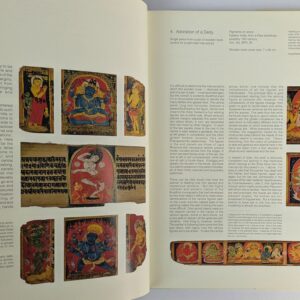
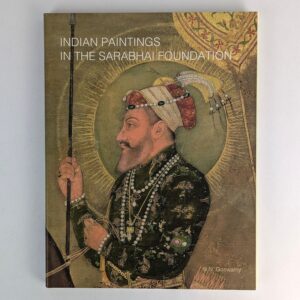
Indian Paintings in the Sarabhai Foundation
AU$50.00 Read MoreAdd to cartB. N. Goswamy
Ahmedabad: Sarabhai Foundation, 2010.Catalogue of paintings in the collection, each with an extended text description.
-
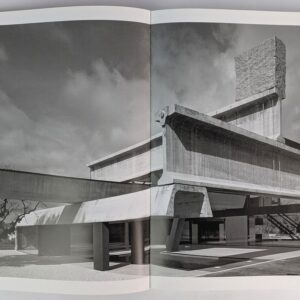
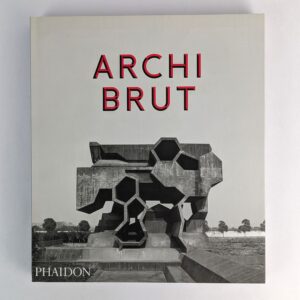
Archi Brut
AU$60.00 Read MoreAdd to cartPeter Chadwick
London: Phaidon, 2017.French edition of This Brutal World, a global survey of Brutalist architecture.
-
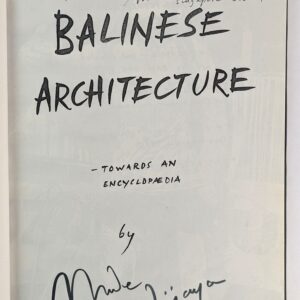
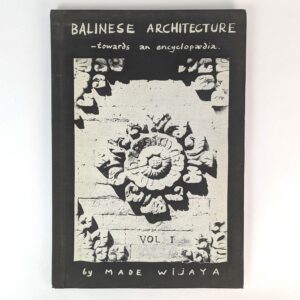
Balinese Architecture: Towards an Encyclopaedia Volume I
AU$300.00 Read MoreAdd to cartMade Wijaya
[Sanur]: Fotokopi, 1984.This book grew out of a report by students of the University of Sydney during a holiday design programme in Bali to which Wijaya was the tutor. “Most of the photographs were taken over the six months April – October, 1984. The selection is comprehensive in that it covers the full spectrum of Balinese Architecture — mountain to coastal, north to south, palatial to makeshift.” (from preface) Made Wijaya (born in Sydney as Michael White, 1953-2016) was a landscape architect who left Sydney for Bali as a break from architectural studies at University of Sydney and stayed, immersing himself in the Balinese culture, consorting with royalty, and in 1975 was renamed Made Wijaya by a priest in a Hindu temple ceremony. Photocopied pages (as issued), this copy with 3 original colour photographs pasted in (copies are known to have differing numbers of added photographs). One of 50 numbered and signed copies, this copy further inscribed by Wijaya to the title page.
-
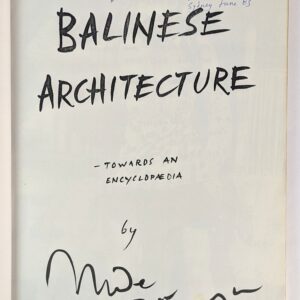
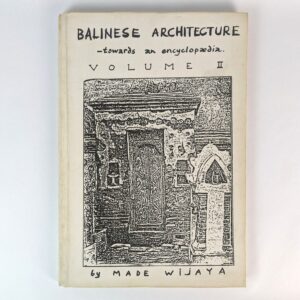
Balinese Architecture: Towards an Encyclopaedia Volume II
AU$300.00 Read MoreAdd to cartMade Wijaya
[Sanur]: Fotokopi, 1985.This book grew out of a report by students of the University of Sydney during a holiday design programme in Bali to which Wijaya was the tutor. “Most of the photographs were taken over the six months April – October, 1984. The selection is comprehensive in that it covers the full spectrum of Balinese Architecture — mountain to coastal, north to south, palatial to makeshift..” (from preface) Made Wijaya (born in Sydney as Michael White, 1953-2016) was a landscape architect who left Sydney for Bali as a break from architectural studies at University of Sydney and stayed, immersing himself in the Balinese culture, consorting with royalty, and in 1975 was renamed Made Wijaya by a priest in a Hindu temple ceremony. Photocopied pages (as issued) with 14 original colour photographs pasted in (copies are known to have differing numbers of added photographs). One of 50 numbered and signed copies, this copy further inscribed by Wijaya to the title page.
-
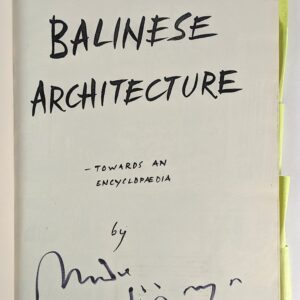
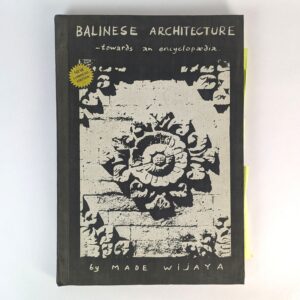
Balinese Architecture: Towards an Encyclopaedia
AU$500.00 Read MoreAdd to cartMade Wijaya
[Sanur]: Fotokopi, 1988.This book grew out of a report by students of the University of Sydney during a holiday design programme in Bali to which Wijaya was the tutor. “Most of the photographers were taken over the six months April – October, 1984. The selection is comprehensive in that it covers the full spectrum of Balinese Architecture — mountain to coastal, north to south, palatial to makeshift..” (from preface) Made Wijaya (born in Sydney as Michael White, 1953-2016) was a landscape architect who left Sydney for Bali as a break from architectural studies at University of Sydney and stayed, immersing himself in the Balinese culture, consorting with royalty, and in 1975 was renamed Made Wijaya by a priest in a Hindu temple ceremony. The New Compiled Edition, combining volumes 1 and 2. Photocopied pages (as issued) with 14 original colour photographs pasted in (copies are known to have differing numbers of added photographs). One of 50 numbered and signed copies, this copy further inscribed by Wijaya to the title page, and with numerous manuscript corrections as well as additional information tabs further describing many of the illustrations
-
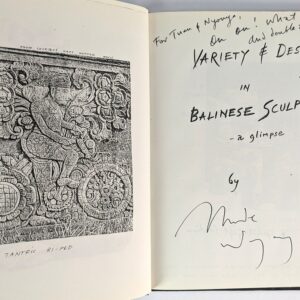
![Variety & Design in Balinese Sculpture - a glimpse [Statues of Bali]](https://www.thebookmerchantjenkins.com/wp-content/uploads/0035951-300x300.jpg)
Variety & Design in Balinese Sculpture – a glimpse [Statues of Bali]
AU$400.00 Read MoreAdd to cartMade Wijaya
[Sanur]: Fotokopi, [1986].“Sculpture is the essence of Balinese Temple & Courtyard decoration: as guardian, shrine angel, diety effigy, bas relief or carved gate. The Balinese have been carving up walls, gates and shrines for at least 1000 years and in that time have digested quirks, twirls, borders, styles, movements and colouring techniques from various foreign cultures: Chinese, Javanese, Portuguese, Dutch, 20th Century Urban. The incredibly dynamic nature of Balinese Art is best expressed in carving and sculpture.” (from foreword) Made Wijaya (born in Sydney as Michael White, 1953-2016) was a landscape architect who left Sydney for Bali as a break from architectural studies at University of Sydney and stayed, immersing himself in the Balinese culture, consorting with royalty, and in 1975 was renamed Made Wijaya by a priest in a Hindu temple ceremony. This work continues his Fotokopi series of architecture/artists books focusing on sculpture, from the mythological to the erotic. This copy with 4 original colour photographs pasted in (copies are known to have differing numbers of added photographs). Issued in a numbered and signed edition of 500 copies, this one of an unknown number of Special Gift Edition copies further inscribed by Wijaya to the title page.
-
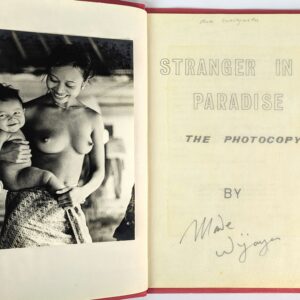
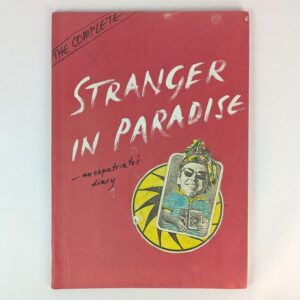
Stranger in Paradise: The Photocopy
AU$500.00 Read MoreAdd to cartMade Wijaya
[Sanur]: Fotokopi, 1981.An Expatriate’s Diary. Made Wijaya (born in Sydney as Michael White, 1953-2016) was a landscape architect who left Sydney for Bali as a break from architectural studies at University of Sydney and stayed, immersing himself in the Balinese culture, consorting with royalty, and in 1975 was renamed Made Wijaya by a priest in a Hindu temple ceremony. This work was his first in his Fotokopi series of architecture/artists books, being a collection of articles recording his observations of life, culture, and architecture in his new home as he attends innumerable religious ceremonies. A detailed record from an expatriate perspective of culture and religion in Bali in the late 1970s. This copy with 3 original colour photographs pasted in (copies are known to have differing numbers of added photographs). Originally published in an edition of only 4 copies, this is the second edition with additional content published in an edition of 100 numbered and signed copies, this copy further inscribed by Wijaya to the contents page. A trade edition was published in 1995.
-
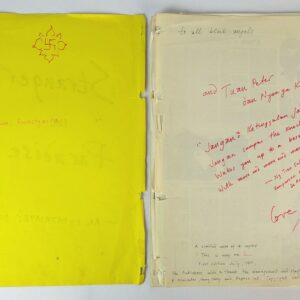
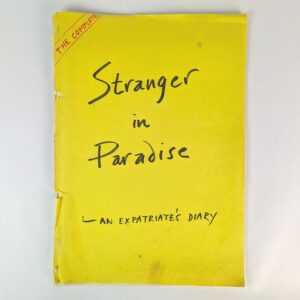
Stranger in Paradise: An Expatriate’s Diary
AU$400.00 Read MoreAdd to cartMade Wijaya
[Sanur]: Fotokopi, 1980.An Expatriate’s Diary. Made Wijaya (born in Sydney as Michael White, 1953-2016) was a landscape architect who left Sydney for Bali as a break from architectural studies at University of Sydney and stayed, immersing himself in the Balinese culture, consorting with royalty, and in 1975 was renamed Made Wijaya by a priest in a Hindu temple ceremony. This work was his first in his Fotokopi series of architecture/artists books, being a collection of articles recording his observations of life, culture, and architecture in his new home as he attends innumerable religious ceremonies. A detailed record from an expatriate perspective of culture and religion in Bali in the late 1970s. This is the First Edition published in an edition of only 4 numbered and signed copies, with a lengthy inscription from the author on the publication information page together with a gratified passport portrait photograph of the author.
-
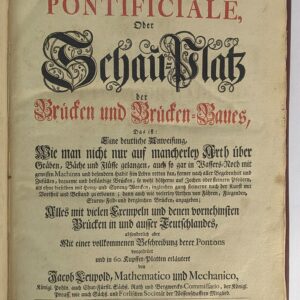
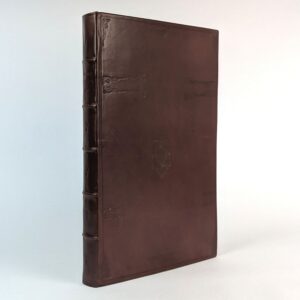
Theatrum Pontificiale, oder Schau-Platz der Brucken und Brucken-Baues
AU$2,000.00 Read MoreAdd to cartJacob Leupold
Leipzig: Christoph Zunkel, 1726.First edition, first printing, of the first book printed in Germany on bridges and bridge-building. From the encyclopedic series of works on mechanical technology and engineering, Theatrum Machinarum, by German physicist, mathematician, and engineer Jacob Leupold (1674-1727). [A clear instruction on how one can not only cross ditches, streams and rivers in various ways, but also save one’s life in times of water with certain machines and special clothing. Furthermore, according to all circumstances and coincidences, convenient and durable bridges, both wooden ones with yokes or stone posts, and without them with rigging and blasting works, as well as entirely of stone, according to art, to build advantageously and permanently. Then also how many examples of sailing, flying, storm-field and similar bridges can be given. All with many examples and the most distinguished makers in and outside Germany, but especially with a complete description of their pontoons, presented and explained in 60 copper plates.] The first 4 plates show a variety of methods for crossing bodies of water including an array of unusual diving and floating devices, the rest devoted to the architecture and engineering of bridges.
-
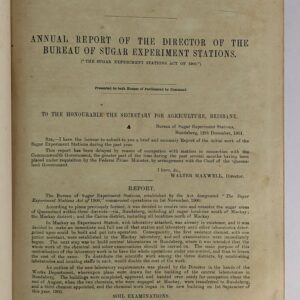
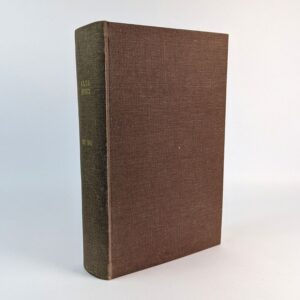
Annual Report of the Bureau of Sugar Experiment Stations, 1901-1943
Read MoreRESERVEDQueensland Government
Brisbane: George Arthur Vaughan, Anthony James Cumming, Frederick Phillips, David Whyte, and A. H. Tucker, Government Printers, 1901-1943.A substantial run from the first annual report of 1901 following The Sugar Experiment Stations Act of 1900 to the forty-third in 1943. Lacking 1927, 1930, 1931, 1935, 1937, 1938, 1942.
-
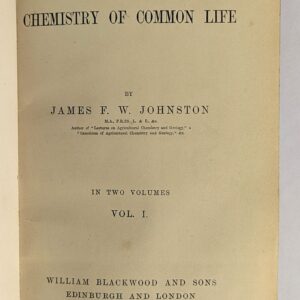
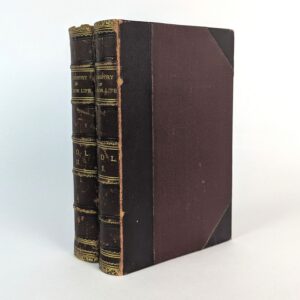
The Chemistry of Common Life (2 Volumes)
AU$150.00 Read MoreAdd to cartJames F. W. Johnston
Edinburgh and London: William Blackwood and Sons, 1855.“The first work in English to treat the entire psychoactive plant kingdom.” (Phantastica, 114) Thorough chapters devoted to opium, cannabis, coca, betel nut, Amanita muscaria, as well as tea, coffee, beer, wine, and liquors.
-
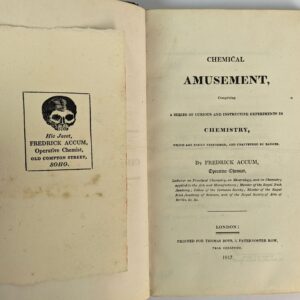
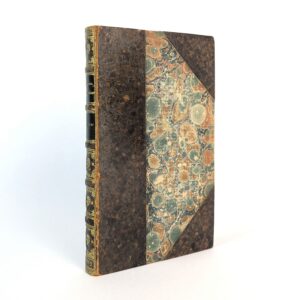
Chemical Amusement, Comprising a Series of Curious and Instructive Experiments in Chemistry,
AU$2,000.00 Read MoreAdd to cartFredrick Accum
London: Thomas Boys, 1817.Which are Easily Performed, and Unattended by Danger. 103 chemistry experiments with magical application for the conjuring chemist. The rare first edition with the 60 page, A Descriptive Catalogue of the Apparatus & Instruments Employed in Experimental and Operative Chemistry, in Analytical Mineralogy, and in the Pursuits of the Recent Discoveries of Voltaic Electricity, Manufactured and Sold by the author, at the rear, the separate title on the verso of pp. 191. Friedrich Accum (1769-1838) was a German chemist who lived in London from 1793 to 1821. He played a key role in the establishment of gas lighting in London and wrote a number of popular chemistry works, most notably campaigning against the unscrupulous use of chemical additives in food in his 1820 A Treatise on Adulterations of Food and Culinary Poisons. HALL 1, TOOLE STOTT 1. This copy in a Zaehnsdorf half leather binding with the author’s calling card laid in and the bookplates of magicians Roland Winder and Ricky Jay.
-
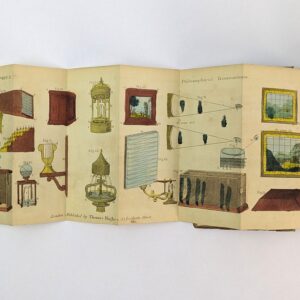
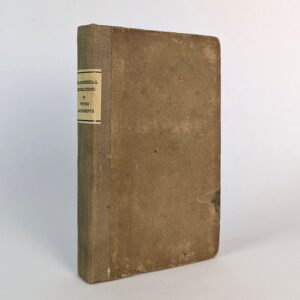
Philosophical Recreations, or Winter Amusements
AU$800.00 Read MoreAdd to cartJohn Badcock
London: T. Hughes, No date.A Collection of Entertaining & Surprising Experiments in Mechanics, Arithmetic, Optics, Hydrostatics, Hydraulics, Pneumatics, Electricity, Chemistry, Magnetisism, & Pyrotechny, Or Art of Making, Fire Works, together with the wonders of the Air Pump, Magic Lanthorn, Camera Obscura, &c. &c. &c. and a variety of Tricks with Cards. (circa 1828). TOOLE STOTT 77.
-
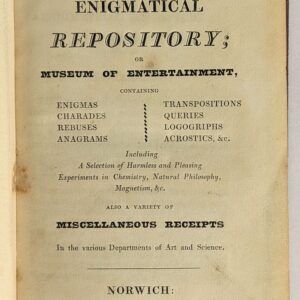
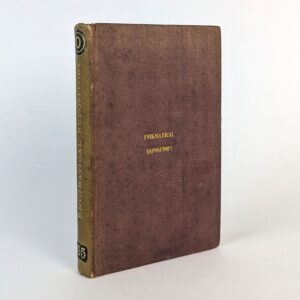
The Enigmatical Repository; or Museum of Entertainment,
AU$300.00 Read MoreAdd to cartJ. Dawson
Norwich: J. Dawson, No date.Containing Enigmas, Charades, Rebuses, Anagrams, Transpositions, Queries, Logogriphs, Acrostics, &c. Including A Selection of Harmless and Pleasing Experiments in Chemistry, Natural Philosophy, Magnetism, &c. Also a variety of Miscellaneous Receipts In the various Departments of Art and Science. A collection of word puzzles and simple chemistry experiments designed for youth amusement. Not in Toole Stott. This copy inscribed by the publisher J. Dawson and from the collection of magician Ricky Jay.
-
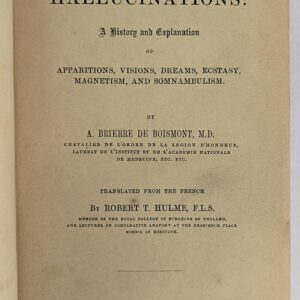
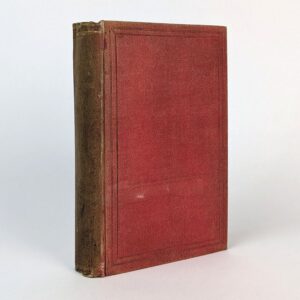
On Hallucinations: A History and Explanation of Apparitions, Visions, Dreams, Ecstasy, Magnetism, and Somnambulism
AU$350.00 Read MoreAdd to cartA. Brierre de Boismont; Robert T. Hulme
London: Henry Renshaw, 1859.The first psychiatric survey of hallucinations by the French physician and psychiatrist Alexandre Jacques Francois Briere de Boismont (1797-1881), first published in English in 1853, on offer here is the first UK edition, translated from the French by Robert T. Hulme. Boismont considered hallucinations to be one of the most important aspects of man’s psychological history.

